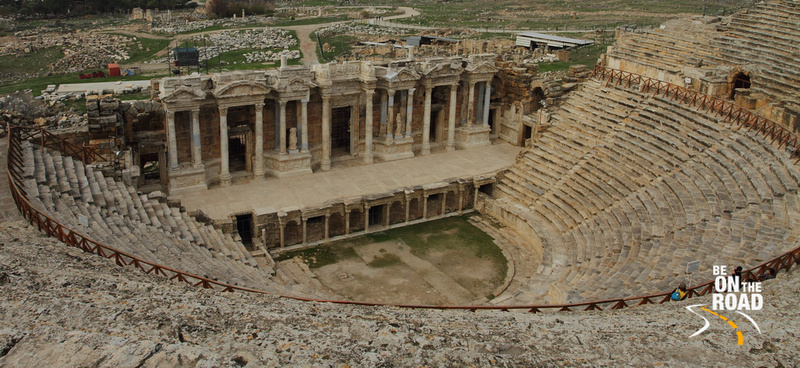Hierapolis: The Ancient Greek Spa City

Turkey is a holiday destination with amazing experiences. It’s unique location on the cusp of Europe, Asia and the Middle East makes it a melting pot of cultures, home to an amazing array of landscapes and a land of delicious food. One such gem in Turkey is the ruins of the ancient Greek city called Hierapolis. Founded in early 2nd century BCE, Hierapolis is a UNESCO world heritage site that in its hey days used to exist as a spectacular spa destination.
This ancient Greek spa city, located on natural hot springs in southwestern Anatolia, was home to spectacular baths, a massive amphitheatre, temples, grand gateways, markets, sacrophagi and much more. Today, its ruins give us a glimpse into its rich past.

It all started when the Phrygians built a temple in the first half of the 7th century BCE, which was used by the people of the nearby villages and towns. Then, in the 2nd century BCE, Hierapolis was founded as a thermal spa. It started as a healing centre, before people started to migrate here to spend their last days in relaxation and peace. With time, Hierapolis or the holy city expanded from being a health centre into a city with numerous temples. In 133 BCE, Hierapolis became the part of the Roman province of Asia after the death of King Attalus III. Then onwards a couple of earthquakes damaged the city and it was entirely rebuilt in the Roman style with imperial financial support. By now, Christianity had made its presence felt in this city.
Then came the golden era of the city starting 129 ACE when the theatre was built for a visit by the emperor Hadrian. And when the Roman Emperor Caracalla visited in 215 ACE and bestowed upon it the title of neocorus, Hierapolis entered the peak phase of this golden era. Roman baths, gymnasium, temples, fountains and markets were built. Hierapolis became one of the more prominent Roman cities in the field of art, philosophy and trade. The citizens started getting richer and the city thrived. All was well till the early part of the 7th century when the town was attacked by Persian armies and then by an earthquake. Thus began the decline of this once great spa city.

As you walk through the ruins of this ancient city, you cannot stop admiring its massive size, be its baths, amphitheatre, temples or just its building columns. Not only are the structures of Hierapolis big, but they were tastefully built with a lot of utility functions. All the remaining stones and ruins tell you a story and each vantage point gives you a majestic view of the landscape that is made up of rocks, stones and white travertines.
You can either take a taxi to Hierapolis, explore the city by foot, enjoy a dip in the thermal waters and walk your way down to the town of Pamukkale through the travertines and waterfalls or you can walk your way up from Pamukkale through the different travertines, exploring every bit of it in the cooler morning weather, then exploring the ancient Greek city of Hierapolis and then walking all the way back to Pamaukkale through a different route in the travertines. Either ways, you are bound to enjoy the ruins of Hierapolis and the travertines of Pamukkale. Throw in a paragliding adventure, a relaxed soak in the hot water springs and a deliciously cooked local meal and you have a dream Hierapolis and Pamukkale holiday experience.

As I had mentioned earlier, Turkey is a holiday destination with many amazing experiences. All you have to do is book your tickets and Turkish visa and you are all set to have a dream vacation that includes the ancient Greek spa city of Hierapolis and many other magical destinations.

How to reach there:
The nearest airport, train station and bus station would be Denizli. Mini buses or dolmus (share taxi) will take you from Denizli to Pamukkale in about 20 minutes.
The well connected and also the cheapest option to reach Denizli would be by bus.
Best season to visit:
Summers tend to be very hot at Pamukkale and Hierapolis. Hence, they can be best avoided. The rest of the year would be ideal to visit Hierapolis and Pamukkale.
Winters can be a bit challenging as you will have to walk barefoot through the freezing waters of the travertines.
Things to keep in mind:
1) Do carry with you a pair of sunglasses to protect your eyes against the heavy reflections coming from the chalky cascades
2) Do carry with you a cap/hat, sunblock, good pair of boots, a bottle of water to protect yourself from the elements
Admission fee:
The entrance fee is 80 Turkish Lira. This includes both Pamukkale travertines and the Roman ruins of Hierapolis

Where to stay:
Pamukkale would be the best place to stay as it offers close proximity to the travertines and to Hierapolis. There are many family run pensions near the travertines for those looking for something more upmarket, while the town has hotels and hostels catering to a wide range of budgets.
Where to eat:
You could either eat at your place of stay in Pamukkale or you could try the delicious street food in the city.
There are also a few restaurants near Hierapolis, where you could get some basic food.

Other nearby tourist attractions:
1) Pamukkale: A UNESCO world heritage site known for its travertines with mineral rich thermal waters&
2) Cappadocia: One of the most magical places in the world
3) Ephesus: An ancient Greek city founded in the early 10th century BC on the west coast of Turkey
4) Aphrodisias: Offbeat Greek culture trail in Turkey
5) Kayakoy: The ghost town of Turkey
;
6) Lycian way: A historic trail with sensational beaches, architectural ruins, rich Greek history and stunning views





























